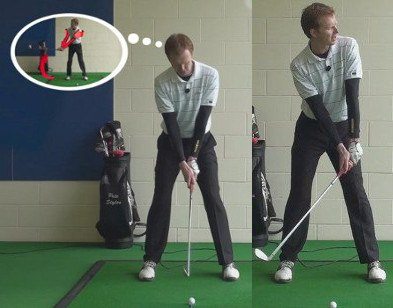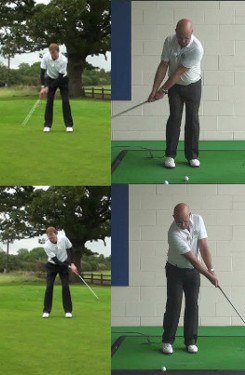You can think of golf rhythm as the speed with which you move throughout the swing – not just at impact, but from the takeaway all the way through to the follow through. It is vital that you use a rhythm that is comfortable to you, and consistent from shot to shot. If your rhythm is constantly changing during a round of golf, you have very little chance of playing your best from the first tee to the last green. Many golfers believe rhythm is something you either have or you don't – but that isn't true at all. You can work on your rhythm just like you can work on any other part of your game. In fact, if you are a golfer that struggles with consistency, rhythm is one of the very first fundamentals that you should target for improvement.
It is easy to get caught up in the technical elements that make up a golf swing. You could spend countless hours reading books on swing theory that cover topics like swing plane, lag, shoulder turn, and much more. Those topics certainly have merit and can be helpful in improving your game, but they shouldn't dominate your thoughts. Focusing on basics like balance and rhythm is not only easier, but it is more effective as well. Put your effort into these two elements of the swing and watch your game quickly start to change for the better.

| GOLF FIXES BY PGA PROS |
|---|
| Improving Rhythm To Stop Shanked Golf Bunker Shots | Video | Article |
| Maintaining Balance And Rhythm For 18 Golf Holes | Video | Article |
| Staying In Rhythm Whilst Swinging Not Lifting | Video | Article |
| Three Ways To Find Your Golf Rhythm | Video | Article |
| LESSONS |
|---|
| Better Rhythm To Improve Your Topped Golf Shots | Video | Article |
| Balance And Rhythm In The Golf Short Game | Video | Article |
| Ensure A Smooth Rhythm To Ensure Good Golf Swing Balance | Video | Article |
| Grooving A Smooth Rhythm To Improve Consistency Of Golf Strike | Video | Article |
| The Powerful Duo Of Balance And Rhythm Can Change Your Golf Game | Video | Article |
| PRACTICE DRILLS |
|---|
| Do You Want A Better Putting Rhythm Theres An App For That | Video | Article |
Think about your last few trips to the driving range for a practice session. What did you work on? Most likely, you paid attention to basic fundamentals like your grip, stance, takeaway, and more. If you are an advanced or experienced player, you might have worked on things like your swing plane, club face position, and other important topics. All of these points are valuable areas to improve, and you can play better golf if you make meaningful progress as a result of your efforts.
But what about your rhythm? If you are like most players, you haven’t spent much time – if any – working on your rhythm. This is an extremely important aspect of the golf swing, yet it goes almost completely ignored by the average player. For those who are serious about playing golf at a higher level, working on rhythm is big step in the right direction.
In this article, we are going to cover the topic of rhythm in golf from a number of angles. We’ll get started by discussing what rhythm is and why it can help you play better golf. Later, we’ll move into topics like how you can find the right rhythm for your swing, what to do when your rhythm gets off-track, and how rhythm can even help you make more putts. There’s a lot to cover on this important topic, so let’s get started!
All of the content below is based on a right-handed golfer. If you happen to play left-handed, please take a moment to reverse the directions as necessary.
— What is Golf Swing Rhythm?
Rhythm in golf refers to the overall tempo of your swing. Ideally, you will have a relatively smooth rhythm from start to finish, without a sudden change in effort or pace anywhere along the way. There is no such thing as a ‘perfect’ rhythm, as this is a point that varies wildly from player to player. You shouldn’t be striving to copy the rhythm of any other player, but rather, you should be striving to find the right rhythm for your game. If you can settle on a rhythm that works for you, it’s likely that you’ll get vastly improved results moving forward.
It’s important to note that a player with a slow swing tempo doesn’t necessarily have good rhythm in his or her swing. There is a tendency by some players to see a golfer with a slow swing and automatically proclaim that the player has a ‘good rhythm’ – but that isn’t necessarily the case. And, just the same, players with fast swings can have great rhythm, even if they don’t look quite as smooth as the player who moves slower. What’s important is not the pace you choose for your swing, but rather than you keep it consistent from start to finish and from swing to swing.
Let’s take a moment to highlight a few of the key benefits you can enjoy when you optimize the rhythm in your swing.

- Consistency. This is the main motivating factor in regard to working on your rhythm. If you can improve your rhythm, you should enjoy improved ball striking consistency – and we probably don’t need to tell you how important it is to be consistent on the golf course. When your swing repeats reliably time after time, you can become more precise with your targets and shoot lower scores at the end of the day. No one is perfectly consistent in this difficult game but working toward improved consistency will make you a better golfer overall.
- Improved power. This is a point that will surprise many golfers. There seems to be a belief among many players that the best way to hit the ball hard is simply to swing as hard as possible – but that’s just not how it works. If you want to hit the ball with authority, you need to be efficient with your mechanics and use an even rhythm to deliver the club to the ball. Without good rhythm in your swing, it’s unlikely that you will be able to maximize your club head speed at the moment of impact. Instead, you will probably max out your swing either before or after the ball, and that means you’ll be wasting power and leaving yardage on the table. With a good rhythm that helps you optimize the speed of your swing at the point where it matters most, you can pick up yardage without feeling like you are swinging any harder.
- Performance under pressure. Do you struggle to hit good golf shots when you get nervous? Don’t worry – you aren’t alone. It’s hard to strike the ball cleanly when you are worried about the outcome of the shot and feeling some form of pressure from an external force. Maybe there are a few people standing around the tee watching you swing, or maybe you are playing in a tournament for the first time. Whatever the case, one of the great challenges in golf is settling those nerves and executing your swing properly. Fortunately, a good rhythm in your swing can help. When you can trust your rhythm, you’ll have something in your swing that you can rely on even when your brain is overwhelmed by the pressure. Those with a reliable swing rhythm tend to perform better under pressure than players who are more focused on the technical positions they reach in the swing. Spend some time in practice mastering your personal swing rhythm and you may find those pressure situations a little easier to handle in the future.
- Perform with minimal practice. For many average golfers, regular practice is just not something that fits into the patterns of day to day life. You have a job to manage, family obligations, other hobbies and chores, etc. By the time you add it all up, it might be tough to squeeze in regular trips to the driving range. One of the benefits of establishing a trustworthy tempo or rhythm in your swing is that you should be able to play only occasionally while still achieving decent results. It would be good to practice as much as you can, of course, but a solid rhythm will help you play well even if it’s been a while since you’ve had a club in your hands.
As stated above, you aren’t trying to copy the perfect swing rhythm of another player, because that doesn’t exist. Even if you see a player on the PGA Tour with what looks to be a perfect rhythm, that swing tempo only works because it is a good fit for the player in question. Don’t try to copy anyone else – work on developing a rhythm that works for you. Once you find it, that swing pace should feel natural and be easy to repeat. In the end, a reliable rhythm can be one of the biggest allies you have on the course.
— Finding Your Ideal Rhythm
The trickiest part of dialing in your swing rhythm is that no one else can tell you exactly what the rhythm of your swing should look or feel like. We can’t tell you exactly how long it should take you to get from address to the top of your backswing, or how long your downswing should take. The timing of your swing is an individual thing, and you’ll inevitably need to figure it out for yourself.
With that said, we won’t leave you completely on your own here. The tips below highlight some things to think about as you try to dial in the right rhythm for your full swing. Keep these points in mind during your practice sessions and hopefully you will be able to make progress on this challenging task.

- Think about your personality. Believe it or not, one of the first steps in the process of identifying your ideal rhythm is to think about your personality off the golf course. What are you like as a person in general terms? Are you relatively laid back and relaxed, or do you always need to be keeping yourself busy? If you are a laid-back person, try to mimic that attitude with a slow and smooth swing. On the other hand, people who move and talk quickly are usually better suited to a quick swing. It’s often the case that good golfers have swings which match up nicely to their personalities. Think about this concept in your own game and adjust your rhythm to line up with your natural personality and tendencies.
- What comes naturally? If you have been playing golf for a long time, try to think back to your early days on the links. How did you naturally swing the club when you didn’t know anything about golf technique? While most people need to alter their natural swing to get good results, it’s also smart not to stray too far from this starting point. After all, your natural swing is what’s comfortable, so try to keep that as the base of your technique while refining it along the way. So, for instance, if your natural swing was rather slow but you have picked up the pace in an effort to hit the ball harder, think about going back to that earlier, more gradual tempo. It’s the combination of natural tendencies and technical improvements that leads most golfers to progress on the course.
- Experiment. Unfortunately, many golfers fail to embrace the idea of experimenting on the driving range. When on the range, you have a perfect opportunity to try different things in your swing without having to worry about the results. So what if you hit some bad shots along the way? That’s just part of the process. If you want to get better at golf, one of the best things you can do is experiment on the range. With regard to rhythm, that means trying faster and slower tempos to see what clicks. Don’t just judge the results based on what kinds of shots you are able to hit – although that is important. You should also be paying attention to how each swing feels and which tempo seems to be a better fit than the rest. Once you decide what kind of rhythm you’ll be going with, you can then get down to the work of repeating it enough to make it comfortable and natural.
Should you expect to find the perfect rhythm for your swing after hitting just a few balls during your next practice session? Probably not. Golf just doesn’t work this way – this is a hard game! However, with some patience and consistent effort you should be able to work your way toward a rhythm that will serve you well on the links for years to come.
— Getting Back in the Groove
In this section, we are going to assume that you are already using a swing rhythm that you are happy with most of the time. You are able to hit solid shots on a fairly regular basis, and your scores have been trending in the right direction. That’s great! But what happens when you get into the middle of a round and suddenly your swing goes missing? This is a perfectly normal thing to happen on the golf course, yet it is highly frustrating. If you struggle to get back on track quickly when your rhythm gets off, the points below should help.

- Slow things down. While golf is a slow game overall, it can feel like things are moving quickly when your game gets off-track. Once you notice that your swing does not feel quite right, make an effort to slow things down and focus on making just a single solid swing. If you have played a couple of bad holes in a row, you might be tempted to get it all back with one heroic shot – but that method rarely works out well. Instead of going that way, slow down your mind and focus on what you could do to get things moving in the right direction once again. Sometimes, that’s a simple as just hitting a green in regulation. When playing an approach shot in this situation, or a tee shot on a par three, aim to the big side of the green and give yourself plenty of room for error. Don’t try to hit a perfect shot – just hit a decent shot that gets your ball onto the green and gets you moving in the right direction once again.
- Hit a simple shot. This point goes right along with the previous idea of hitting a shot to the big part of a green. To go a step further, you could alter your club selection on a tee shot just to get the ball in play and build some confidence. Even if you are playing a hole where you would normally use a driver, consider reaching for a three wood or hybrid club in an effort to find the short grass. When you use this strategy, it’s important not to take the shot for granted – you still need to focus and do your best to execute a good swing. You might even find that it’s necessary to play a couple of holes in a conservative manner until you can regain your rhythm and start to play your normal game once again. This is a good way to ‘weather the storm’ and get through a rough patch without doing too much damage to your scorecard.
- Focus on your pre-shot routine. If you have lost your rhythm in the middle of a round, there is a chance you’ve gotten away from your pre-shot routine at the same time. While going through a good routine isn’t a guarantee for success, it should help bring you back to the fundamentals of what helps you play your game properly in the first place. Be sure to go through your routine fully before each shot and pay attention to even the small details of the process. In a game where it is easy to let your mind run away with all sorts of bad thoughts when things go wrong, a good pre-shot routine can help you regain focus and get back on the right track.
It is always frustrating when your golf swing doesn’t perform as expected in the middle of a round. However, you don’t have to let a couple of bad swings turn into a terrible score. Focus on the basics, slow yourself down, and get back to the task of putting the ball in the right spots on the course.
— Rhythm in the Short Game
Having a reliable rhythm in your short game is just as important as it is in your long game. You’ll never achieve the kind of consistency you desire with your chipping and putting if you fail to establish a rhythm you can trust. Just like with the long game, you are free to figure out what kind of tempo works for you on short shots – you don’t have to mimic the style of anyone else.
If you feel like you are currently searching for a good rhythm for your short game, consider the tips below.

- Even is the key. Keeping your tempo even is absolutely essential in the short game. That is the case because short shots are all about distance control. It’s not terribly hard to get the ball on line for short shots, but you do need to control the speed of the shot accurately if you are going to get a good result. Hitting short shots too hard or too soft will leave you out of position and at risk of spending an extra stroke before you complete the hole. While you work on your short game technique, pay attention to the pace of the swing or stroke and try to keep it as even as you can from start to finish. In other words, you don’t want any dramatic change of speed at any point along the way. It may take some work to even out your pace, but this is one of the most beneficial changes you can make to your short game.
- Match up with your long game. Generally speaking, you’ll be well-served to match the pace of your full swing to the pace of your short game swings. So, if you use a quick swing when hitting drives and approach shots, a quick tempo on and around the greens might be the way to go. Likewise, players with smooth and slow tempos shouldn’t change anything just because they get closer to the hole. Although this is a good rule of thumb and a good starting point, it’s possible that you will find changing your tempo between the full swing and the short game is the best choice for you. That’s okay, just be sure it really is your best option before you go too far down that road.
- Don’t forget your fundamentals. It is important to have a good rhythm in your short game, but that doesn’t mean you will be able to get away with shoddy fundamentals. You still need to have your technique under control if you want to make putts and hit great chips and pitches. For starters, you’ll want to use soft grip pressure on most of your short game shots, especially putts and basic chip shots. Also, you need to master the art of keeping your head still while you play shots on and around the greens. Moving your head early is a common mistake, and it will almost always lead to disappointing results. Spend some time working on the rhythm of your short game, but also spend consistent practice time on your fundamentals so you don’t fall off track with your technique.
We hope you have picked up some valuable information from this article on rhythm in golf. There are plenty of other important pieces of the golf puzzle, of course, but don’t overlook the value of rhythm as you practice your game and work toward lower scores. Good luck!






